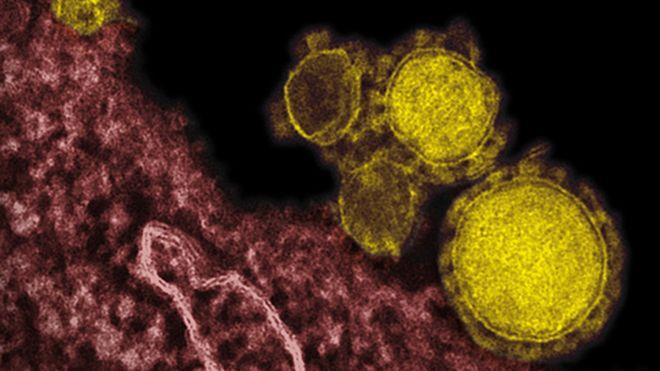July 22, 2013

This undated electron microscope image made availalbe by the National Institute of Allergy and Infections Diseases – Rocky Mountain Laboratories shows novel corona virus particles, also known as the MERS virus, colorized in yellow.
July 22, 2013

This undated electron microscope image made availalbe by the National Institute of Allergy and Infections Diseases – Rocky Mountain Laboratories shows novel corona virus particles, also known as the MERS virus, colorized in yellow.
LONDON: India has been named as among the countries that face the highest risk of importing the deadly MERS coronavirus. International scientists on Saturday warned India that the new SARS-like virus that has emerged in the Middle East could spread faster and wider during two international mass gatherings involving millions of people in the next few months.
For the first time ever, scientists analyzed worldwide airline traffic and historic Haj data to predict population movements in and out of Saudi Arabia and the Middle East during two mass gatherings to help countries assess their potential for MERS introduction via returning travellers and pilgrims.
Scientists from St Michaels Hospital in Toronto have named India as among those facing the highest risk, with Mumbai and Kozhikode at the top of the list of susceptible cities.
Around 1.7 lakh Indian Muslims will visit Haj this year.
The MERS coronavirus, which appears to have emerged in the Middle East in early 2012, has spread to several countries in Western Europe and North Africa where there have been localized clusters of cases.
Worldwide about 80 cases have been confirmed, with a mortality rate of more than 50%.
The team found that of the 16.8 million travellers who flew on commercial flights out of Saudi Arabia, Jordan, Qatar and the United Arab Emirates between June and November 2012 (the period starting one month before Ramzan and ending one month after the Haj), 51.6% had destinations in just eight countries—India (16.3%), Egypt (10.4%), Pakistan (7.8%), Britain (4.3%), Kuwait (3.6%), Bangladesh (3.1%), Iran (3.1%) and Bahrain (2.9%).
Two cities from India—Mumbai and Kozhikode—were among the 12 like Cairo, Kuwait City, London, Bahrain, Beirut, Dhaka, Karachi, Manila, Istanbul and Jakarta that each received more than 350,000 commercial air travellers between June and November 2012 from the four countries where MERS cases have been traced back to.
Scientists therefore say there is high potential for the virus to spread faster and wider in India during two annual events that draw millions of domestic and foreign Muslims to Saudi Arabia.
The first is Umrah, a pilgrimage that can be performed at any time of year but is considered particularly auspicious during the month of Ramadan, which this year began on July 9 and ends on August 7. The second is the Haj, a five-day pilgrimage required of all physically and financially able Muslims at least once in their life. It takes place from October 13-18 this year and is expected to draw more than 3 million people.
The scientists say "collectively, India, Pakistan, Bangladesh, Afghanistan and Nepal represent the final destinations of nearly one-third of all international air travellers".
They also used World Bank economic and per capita health care expenditure data to help gauge individual countries' abilities to detect imported MERS in a timely manner and mount an effective public health response.
Researchers led by Dr Kamran Khan, an infectious disease physician said "With millions of foreign pilgrims set to congregate in Mecca and Medina between Ramadan and the Haj, pilgrims could acquire and subsequently return to their home countries with MERS, either through direct exposure to the as-of-yet unidentified source or through contact with domestic pilgrims who may be infected."
In contrast to SARS, where the disease was introduced into predominantly high-income countries through air travel, more than half of all air travellers departing Saudi Arabia, Jordan, Qatar and UAE have final destinations in low or lower-middle income countries. Two-thirds of all hajj pilgrims originate from low or lower-middle income countries.
"Given that these countries have limited resources, they may have difficulty quickly identifying imported MERS cases, implementing rigorous infection control precautions and responding effectively to newly introduced cases," Dr Khan said.
Courtesy: TOI







































































































